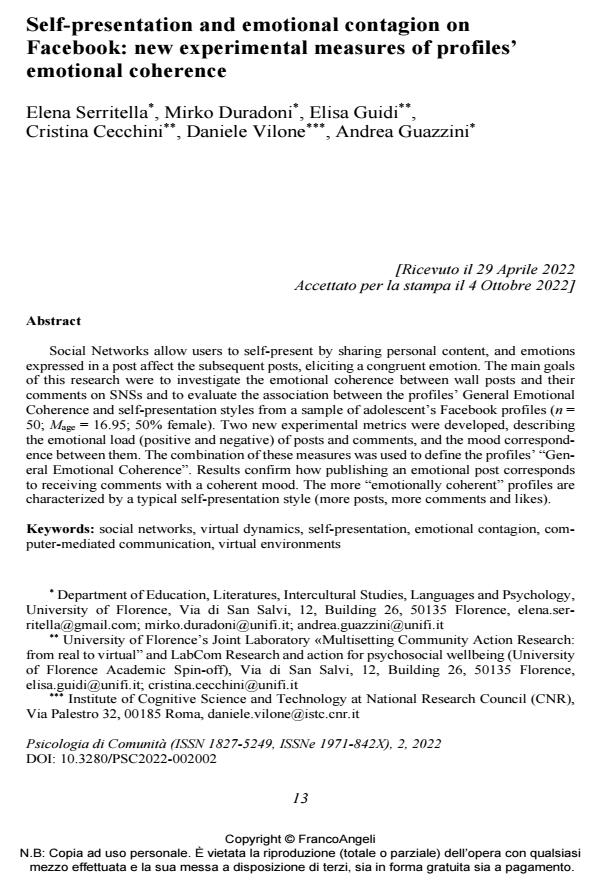Self-presentation and emotional contagion on Facebook: new experimental measures of profiles’ emotional coherence
Titolo Rivista PSICOLOGIA DI COMUNITA’
Autori/Curatori Elena Serritella, Mirko Duradoni, Elisa Guidi
Anno di pubblicazione 2022 Fascicolo 2022/2
Lingua Inglese Numero pagine 21 P. 13-33 Dimensione file 233 KB
DOI 10.3280/PSC2022-002002
Il DOI è il codice a barre della proprietà intellettuale: per saperne di più
clicca qui
Qui sotto puoi vedere in anteprima la prima pagina di questo articolo.
Se questo articolo ti interessa, lo puoi acquistare (e scaricare in formato pdf) seguendo le facili indicazioni per acquistare il download credit. Acquista Download Credits per scaricare questo Articolo in formato PDF

FrancoAngeli è membro della Publishers International Linking Association, Inc (PILA)associazione indipendente e non profit per facilitare (attraverso i servizi tecnologici implementati da CrossRef.org) l’accesso degli studiosi ai contenuti digitali nelle pubblicazioni professionali e scientifiche
Social Networks allow users to self-present by sharing personal content, and emotions expressed in a post affect the subsequent posts, eliciting a congruent emotion. The main goals of this research were to investigate the emotional coherence between wall posts and their comments on SNSs and to evaluate the association between the profiles’ General Emotional Coherence and self-presentation styles from a sample of adolescent’s Facebook profiles (n = 50; Mage = 16.95; 50% female). Two new experimental metrics were developed, describing the emotional load (positive and negative) of posts and comments, and the mood correspondence between them. The combination of these measures was used to define the profiles’ "General Emotional Coherence". Results confirm how publishing an emotional post corresponds to receiving comments with a coherent mood. The more "emotionally coherent" profiles are characterized by a typical self-presentation style (more posts, more comments and likes).
I social network permettono agli utenti di auto-presentarsi condividendo contenuti perso-nali; le emozioni condivise influenzano i post successivi, suscitando un’emozione congruente. Gli obiettivi principali di questa ricerca sono stati: (i) indagare la coerenza emotiva tra i post in bacheca e i loro commenti sui SNS, e (ii) valutare l’associazione tra la Coerenza Emotiva Ge-nerale dei profili e gli stili di autopresentazione su un campione di profili Facebook di adole-scenti (n = 50; età media = 16.95; 50% di sesso femminile), costruendo due nuove metriche per la valutazione del carico emotivo (positivo e negativo) di post e commenti e della loro cor-rispondenza emotiva. La combinazione di queste misure generava la "Coerenza Emotiva Generale" dei profili. I risultati confermano che pubblicare un post emotivo corrisponde a ricevere commenti con uno stato d’animo coerente. Inoltre, i profili più "emotivamente coerenti" sono caratterizzati da un tipico stile di auto-presentazione (più post, più commenti e like).
Parole chiave:social networks, dinamiche virtuali, auto-presentazione, contagio emotivo, co-municazione mediata da computer, ambienti virtuali
Elena Serritella, Mirko Duradoni, Elisa Guidi, Self-presentation and emotional contagion on Facebook: new experimental measures of profiles’ emotional coherence in "PSICOLOGIA DI COMUNITA’" 2/2022, pp 13-33, DOI: 10.3280/PSC2022-002002